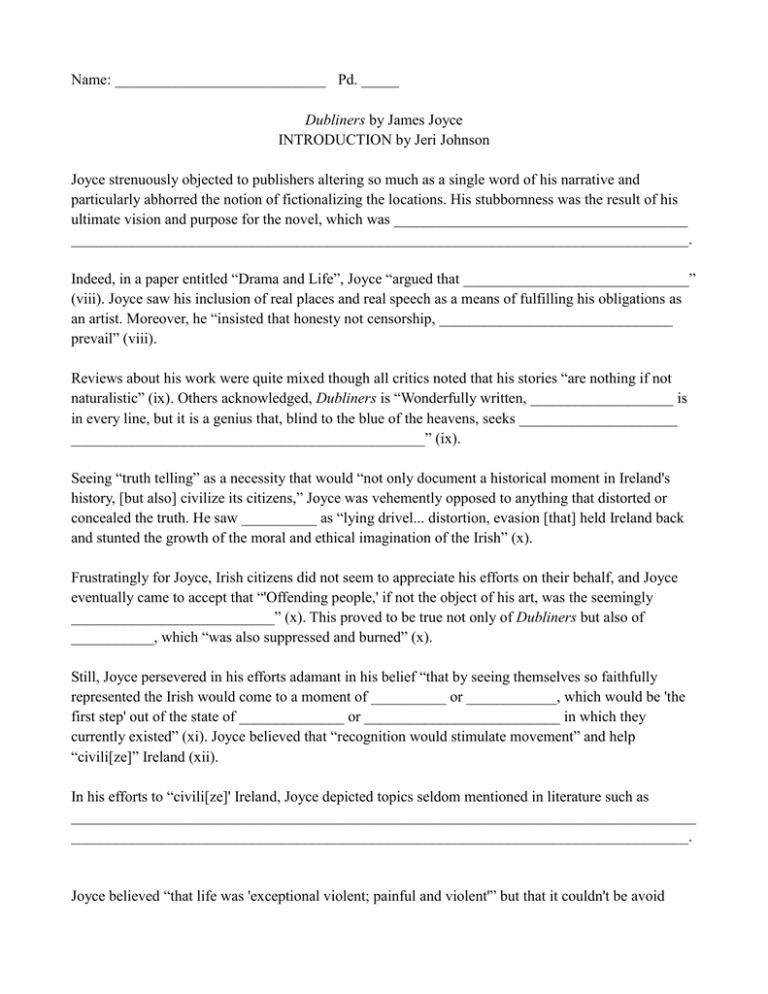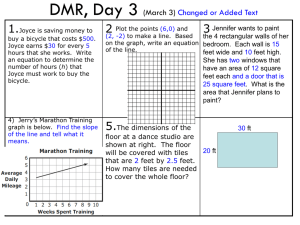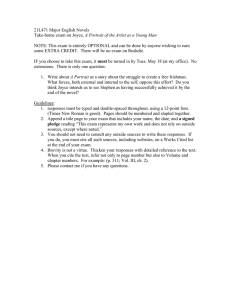Name: ____________________________ Pd. _____ INTRODUCTION by Jeri Johnson
advertisement

Name: ____________________________ Pd. _____ Dubliners by James Joyce INTRODUCTION by Jeri Johnson Joyce strenuously objected to publishers altering so much as a single word of his narrative and particularly abhorred the notion of fictionalizing the locations. His stubbornness was the result of his ultimate vision and purpose for the novel, which was _______________________________________ __________________________________________________________________________________. Indeed, in a paper entitled “Drama and Life”, Joyce “argued that ______________________________” (viii). Joyce saw his inclusion of real places and real speech as a means of fulfilling his obligations as an artist. Moreover, he “insisted that honesty not censorship, _______________________________ prevail” (viii). Reviews about his work were quite mixed though all critics noted that his stories “are nothing if not naturalistic” (ix). Others acknowledged, Dubliners is “Wonderfully written, ___________________ is in every line, but it is a genius that, blind to the blue of the heavens, seeks _____________________ _______________________________________________” (ix). Seeing “truth telling” as a necessity that would “not only document a historical moment in Ireland's history, [but also] civilize its citizens,” Joyce was vehemently opposed to anything that distorted or concealed the truth. He saw __________ as “lying drivel... distortion, evasion [that] held Ireland back and stunted the growth of the moral and ethical imagination of the Irish” (x). Frustratingly for Joyce, Irish citizens did not seem to appreciate his efforts on their behalf, and Joyce eventually came to accept that “'Offending people,' if not the object of his art, was the seemingly ___________________________” (x). This proved to be true not only of Dubliners but also of ___________, which “was also suppressed and burned” (x). Still, Joyce persevered in his efforts adamant in his belief “that by seeing themselves so faithfully represented the Irish would come to a moment of __________ or ____________, which would be 'the first step' out of the state of ______________ or __________________________ in which they currently existed” (xi). Joyce believed that “recognition would stimulate movement” and help “civili[ze]” Ireland (xii). In his efforts to “civili[ze]' Ireland, Joyce depicted topics seldom mentioned in literature such as ___________________________________________________________________________________ __________________________________________________________________________________. Joyce believed “that life was 'exceptional violent; painful and violent'” but that it couldn't be avoid (xiii). The best hope for improving life, “the cure” so-to-speak “was __________________________” (xiii). In fact, according to Joyce, “[w]hat makes most people's lives unhappy is __________________ _______________, some unrealizable or misconceived idea. In fact you may say that __________ is the ruin of man” (xiii). Dubliners was meant to present four different aspects of life to the public: ___________, ___________, ________________, and _________________. “The stories are arranged in this order” (xiv). However, Joyce adhered to the Roman divisions for these categories of life, which means that “_____________ (pueritia) extended to age ____; _______________ (adulescentia) from ______ to _______; ___________ (juventus) from ________ to _______; and ________ (senectus) from _____ to _____” (xv). Part of Joyce's genius with Dubliners is that he manages to “give us multiple distinctive individuals who collectively stand as representative” (xvi). In other words, his characters “are at once 'real' and 'symbolic.' This symbolism can be seen finally in the way that the stories represent not only a metamorphosing human subject [but also] collectively represent _______ itself” (xvi). Consequently, the significance of nearly every detail in Dubliners must be considered from multiple angles. For example, a list of the bars Farrington in “Counterparts” drinks his way through serve not only to recreate Ireland but also to illustrate “the literal lengths Farrington will go far a drink” (xix). Similarly, a harp is not just a harp with Joyce but also a representation of _________ and her “mournful, “weary,” abused state of existence (xx). Still, the very details which make Dubliners so noteworthy are also what make it a difficult text for the everyday reader for Joyce expected his audience to be intimate with Ireland and its history, and any reader who is not will inevitably miss lay certain layers. For example, “Joyce exercised his extraordinary ability to muster not only facts but ____, to employ __________ and to draw with great deftness and humour human characters who just plain get it wrong” (xxii). Of course, only an audience familiar with Ireland's history could catch these alterations and realize that Joyce uses them to illuminate just how blind and ignorant his characters are. Joyce’s assumption of his audience familiarity with Ireland’s history is part of what lead to a style dubbed ____________________ (xxiv). However, a failure to provide historical background is only one aspect of this style. Joyce also relies heavily on imagery and suggestion to convey his main ideas. This fact often means how his characters speech and the silences (ellipses) in their speech are equally – if not more important – then what they actually say. Moreover, Joyce has a tendency to end his stories suddenly. “Never do they offer the kind of summary insight reader might more usually expect form the ending of a short story” (xxvi). Again, this decision to refrain from spelling out his meaning was an intentional tactic Joyce employed to seduce his (hopefully Irish) readers into identifying with the characters and drawing a conclusion which would then tell the reader as much about him or herself as the character. In “Araby,” each character then is both a character and a symbol. Johnson suggests that Mangan’s sister becomes for the main character _____________________ and that the boy’s visit to the bazaar constitutes a type of romantic quest (xxvi). Johnson also suggests that Joyce deliberately used words whose Latin roots (a connection to the Roman Catholic Church) held extra significance; for example: ________from the Latin ________meant _____________________and “might just as well refer to _________________________________________________ as it does to the boy himself” (xxvii). Joyce also borrowed the term __________ from the Catholic Church. “________ applied to literature has come to mean ________________________________, either for character or reader;” however, Joyce’s characters’ revelations subtly different from this definition as they are said to “c[o]me in _____...by which people betrayed the very things they were most careful to conceal” (xxvii-xxviii). While epiphanies are a staple throughout Dubliners, so too is Joyce’s use of “_____________ - the rhetorical figure of incompletion: literally _____________” (xxx). This device was again both a literal and symbolic representation of a feature of Irish culture. It literally depicted real dialogue and symbolically revealed how Irish society insisted some topics were not to be explicitly discussed – how it mitigated, romanticized, or flat-out ignored the grimmer aspects of life and how this tendency stifled and confined the potential of its citizens. This ______, of “immobility, an inability to escape, or move out of the grooves of thought or action they have slotted themselves (or been slotted) into affects all the characters in Dubliners to some degree as they, like Johnny the horse in ‘The Dead’ who orbits the equestrian statute of King Billy, move ‘_________________________” (xxxi-xxxii). “ ‘__________ -- the exchange of spiritual for temporal [concrete or material] things—echoes also throughout the book” (xxxii). As do the ideas surrounding Joyce’s use of the word Gnomon-_______________________ [which] corresponds to ____________________, to _________________ _________________________, to ________________________ or to _________________ or ______________________ or ________________________________ (xxxiii). Ultimately, Joyce’s ambiguity means what we see reflects in large part who we are. Thus, “‘Objective critics’ should come armed with ________________________________________________________________________ __________________________________________________________________________________. This awareness is especially necessary in “_____________[, which] has frequently been described as one of the greatest short stories written in English” (xxxiv-xxxv). As with Joyce’s other short stories, much of the tale’s greatness is Joyce’s ability to create a deceptively complex piece. Indeed, Johnson notes his belief that even many critics miss the true depth of this tale and allow themselves to be too quickly seduced by Gabriel’s view of things. Accepting Gabriel’s view means that, in the end, he _____________________________________________________________. However, Johnson suggests an alternate reading of _________________________________________ is just as valid. Ultimately, he concludes that the reader’s view of Gabriel at the end reflects his or her beliefs about his or her own ability to change.





